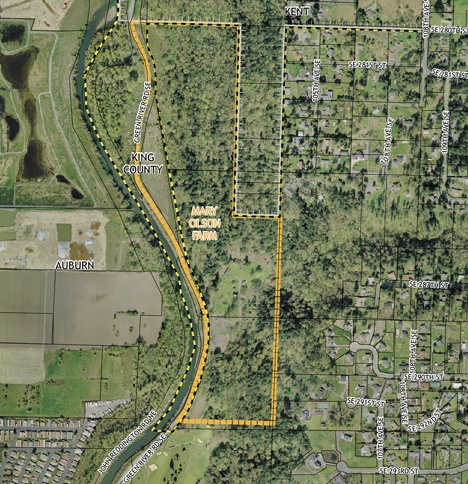Before Alfred and Anna Olson sold the 6.5-acre triangular strip of land on the north end of their Green River Road farm to King County decades ago, it had been their major field, as the piles of drying hay captured in aerial photographs dating to the 1930s clearly attest.
Today, unhappily, too many people misuse the land north of the farm, much of it covered in blackberry bushes, as a trash dump.
Now that same strip of land is destined to be a vital part of the restored Mary Olson Farm, providing a place for features the brother and sister could never have imagined there — public restrooms, a parking lot and a path leading from the parking lot to the barn at the heart of the restoration project. Part of it will be returned to an agricultural function like grazing animals or growing hay.
With that parking lot built, the City can open the turn-of-the-century farm to the public in the summer of 2010.
On Monday, Auburn City Council members expect to vote on a measure to annex the 6.5-acre county-owned parcel. Annexing it will allow for a speedier permitting process by the City of Auburn than King County could offer, Patricia Cosgrove, director of the White River Valley Museum, said Monday.
“We’re talking about six months versus two years,” Cosgrove said.
Mary Olson farm is comprised of five parcels of land, and all but the parcel in question are already City owned, Cosgrove said.
“This concerns the northwest parcel that we euphemistically call the north meadow, but it’s actually the north blackberry patch,” Cosgrove said. “…The idea is to create a low-impact, small parking facility and turn the bulk of it back into the hayfield it was and do some environmental restoration around the edges.”
For visitors, the adventure will begin in the parking lot, leading from there along a compacted gravel pathway to the base of an old wagon road then east and up and over the hill.
“As we worked through King County’s process for permitting a low-impact parking facility, we found that the timeline was stretching out to such an extent that it would prohibit us from opening the farm next summer because we wouldn’t have a parking lot,” Cosgrove said.
City attorney Dan Heid suggested a more direct route for annexing properties that are adjacent to other pieces of land owned by the city that serve a public benefit. This process allows the City Council, by majority vote, to annex property for municipal purposes, and a parking lot is such a purpose.
“It’s still a complex permitting process,” Cosgrove said. “If other things fall into place, this ought to be a little speedier and allow us to open Olson Farm in the summer of next year.”
The city owns the farm and leases it to the White River Valley Museum for stewardship and restoration. The museum is raising funds to restore the farmstead’s buildings and landscape, develop visitor amenities and interpret the farm’s rich heritage. Interpretation will center on family farm economics, stories of immigration, environmental history, and the native landscape.


